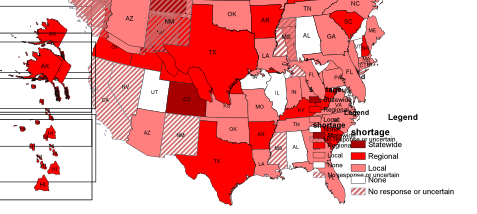
By Mike Hightower, Distinguished Member of the Technical Staff, Sandia National Laboratories
Water is an integral part of energy development, production, and generation. Water is used directly in hydroelectric power generation and is used extensively for thermoelectric power plant cooling and air emissions control. Water is also used extensively in energy-resource extraction, refining, and processing, as well as for energy resource transportation. Therefore, as global energy consumption continues to increase, as much as 50% by 2030, so will the demand for water supplies and resources to support this growth. This will place the energy sector into greater competition with other water users for already limited fresh water resources in many regions of the world. This competition for water resources will likely impact regional energy reliability and energy security.
While the issues of the interdependencies between energy and water were highlighted in initial studies in the United States (DOE, 2007), concerns over energy and water security and reliability are being recognized worldwide by energy officials, energy and water managers, and the scientific community. For example, the World Economic Forum published a report in early 2009 discussing concerns about water demands for energy and potential global impacts that could occur on energy availability, reliability, and security (WEF, 2009). Likewise, the World Energy Council in September 2010 published a report on “Water for Energy”, highlighting that “In recent decades, the combination of more users, with more uses of water has transformed the traditional water-energy ladder that underpins all human, social, and economic development into an escalator” (WEC, 2010). As nations try and balance the demands and availability of water resources to support human health and economic development in the coming decades, it is clear that the water footprint, like the carbon footprint, will become an increasingly critical factor to consider for secure, reliable, and sustainable energy development worldwide.
Reducing the Energy Sector Water Footprint
The projected water demands for electric power generation, carbon sequestration or reduction requirements, alternative transportation fuels to reduce imports – such as biofuels, oil shale, oil sands, coal-to-liquids, hydrogen, and development of natural gas supplies from gas shales, will intensify competition for already limited fresh water resources in many regions. Many of the efforts noted are to ostensibly reduce energy imports by using domestic energy supplies to increase energy security, but in reality they could negatively impact both energy and water security. Therefore, approaches are needed that can increase freshwater use efficiency and reduce the freshwater footprint of current and emerging energy options. Water-related energy concerns can be addressed in a number of ways including; developing additional surface water storage infrastructure and ground water supplies, transferring water from the agricultural sector or from different regions, improving water conservation and water use and reuse efficiency, improving and integrating water and energy planning, or using non-traditional water resources – such as saline and waste water - to offset fresh water use.
To provide a the general overview of the relative scale of the emerging energy and water interdependencies and security issues, recent efforts in the United States to assess and address potential energy and water conflicts are highlighted. In 2005, the U.S. Congress funded the Department of Energy to first, prepare an Energy-Water Report to Congress to identify and quantify emerging energy and water challenges and interdependencies, and second, to conduct a series of regional workshops to identify the science and technology needed to address and reduce the identified emerging energy and water challenges. Both efforts were coordinated by Sandia National Laboratories with the support of all the U.S. national laboratories. The information collected for both efforts is available on the Sandia web site at www.sandia.gov/energy-water.
As identified in the U.S. Energy-Water Report to Congress, over 50 percent of current daily water withdrawals in the U.S. and about 25 percent of all current daily non-agricultural fresh water consumption are for energy-related uses. As the population and economy of the U.S. grow, the demand for both energy and water are also expected to grow. While the water needs to meet the growth for electric power generation and transportation fuels production will depend on the type and number of power plants built, cooling technologies used, air and carbon emission requirements, and the type and quantity of alternative fuels used, estimates suggested that water consumption by the energy sector could grow by a factor of three to four by 2035, increasing from about 4.3 billion gallons of water per day (BGD)(17 billion liters per day) in 1995, to about 12-15 BGD (47-60 billion liters per day) by 2035. This would make the energy sector the largest non-agricultural water consumption sector in the U.S.
The projected growth in water demand for energy generation and development over the next two decades will occur at a time when the nation’s fresh water supplies are becoming increasingly stressed. These water issues were summarized in a U.S. General Accountability Office (GAO, 2003) report on water availability:
“National water availability and use has not been comprehensively assessed in 25 years, but current trends indicate that demands on the nation’s supplies are growing. In particular, the nation’s capacity for storing surface-water is limited and groundwater is being depleted. At the same time, growing population and pressures to keep water in stream for fisheries and the environment places new demands on the freshwater supply. The potential effects of climate change also create uncertainty about future water availability and use.”
Figure 1 summarizes the results of a survey of state water managers in the U.S. from the GAO report showing a general, nation-wide, concern about future water shortages in the next decade under average water supply conditions. Droughts in several regions across the U.S. from 2005 through 2008 drew even more attention to regional water issues. The data in Figure 1 highlight the growing concerns over fresh water supplies in the U.S., and suggest that water problems are no longer just a western U.S. concern, they have become a national issue. The data suggest that competition for increasingly limited water resources in many parts of the U.S. will likely impact projected regional energy development and therefore associated energy supply reliability and security.

Figure 1. Expected State Water Shortages by 2013 for Average Conditions (GAO, 2003)
While the U.S. Energy-Water Report to Congress focused on identifying emerging U.S. energy and water interdependencies challenges and concerns, the regional workshops were organized to look at energy and water needs from a broad spectrum of disciplines, and identify research efforts needed to minimize future conflicts between energy and water development and foster more reliable and sustainable use of these two very important natural resources. More than 500 participants representing federal, state, local and tribal water and/or energy agencies, water and energy managers, water and energy utilities and industrial associations, environmental groups, technology developers, and academia from across the U.S. participated in the Energy-Water workshops that took place from November 2005 through May 2006. Based on these workshops, three major directions to address the emerging energy and water interdependencies challenges were identified. A short overview and summary of the energy research needs and directions suggested were published by Sandia (Pate et al, 2007). The three major science and technology research and developments directions identified from the workshops are summarized included:
Reduce fresh water use in electric power and transportation fuels development. Several renewable energy technologies and alternative cooling approaches for thermoelectric power plants exist that could reduce water consumption for electric power generation. Improving dry, hybrid, and other alternative cooling technologies and carbon sequestration approaches could lower future water consumption. Likewise, research to address the issues limiting low water use renewable energy technology implementation such as electric grid integration, cost, and dispatchability could accelerate their use, reducing both water consumption and carbon emissions, important system-level operational requirements. Finally, since virtually all alternative transportation fuels currently being considered will increase fresh water consumption, any major scale-up of alternative transportation fuels must consider approaches that use less fresh water and improve water use efficiency in growing, mining, processing, and refining future fuel resources.
Develop materials and water treatment approaches to enable non-traditional water use in energy generation and refining. With limited fresh water supplies, waste water reuse and non-traditional water use including sea water, brackish ground water, and produced water, could be increased to meet water demands in many sectors. New water treatment technologies will be needed that can meet the water quality requirements at much lower energy use. Improvements in materials that minimize fouling would reduce the need for higher quality waters, significantly expanding opportunities to replace fresh water with lower quality waters. A wide range of technology improvements in organics removal, bacterial treatment and disinfection, reduction of membrane fouling, and improvements in salt removal and concentrate management and reuse, are areas where technological improvements could significantly reduce energy use in water treatment and pumping, as well as accelerate the use of non-traditional water resources by the energy sector.
Improve water assessment, and energy and water systems analysis and decision tools. Compounding the uncertainty of available water supplies is a lack of data on water consumption. Without water consumption data it is impossible to accurately determine resources available for use. Improved water data collection, better water monitoring and sensors, and improved assessment of non-traditional water resources are needed to effectively quantify our water resources. Also, improved decision support tools and system analysis approaches are needed to help communities and regions better address emerging natural resource - energy, water, land, and environment - demand and availability challenges. Tying improved water availability data with decision support and planning tools would improve collaboration on energy and water planning and support system-level solutions that can improve energy reliability and reduce fresh water consumption.
While a final report on the energy water research priorities for the U.S. Department of Energy has not yet been published, the data presented in the Pate report does provide a reasonable overview of the global energy and water research directions and technology improvements needed to reduce the water footprint of future energy development. Similar energy and water challenges and research needs have been identified and highlighted in recent studies in many countries and regions including Canada, Australia, Europe, and Asia. Again, as nations try and balance the demands and availability of water resources to support human health and economic development in the coming decades, developing technologies and approaches to reduce the water footprint of the energy sector will become an increasingly critical factor to in maintaining global energy security, reliability, and sustainability.
References
DOE (2007). “Energy Demands on Water Resources: Report to Congress on the Interdependency of Energy and Water.” U.S. Department of Energy, January 2007.
GAO (2003). “Fresh water Supply: State’s Views of How Federal Agencies Could Help them Meet the Challenges of Expected Shortages,” Government Accountability Office, 2003.
Pate (2007). “Overview of Energy-Water Interdependencies and the Emerging Demands on Water Resources,” SAND2007-1349C, Sandia National Laboratories, March 2007.
WEC (2010). “Water for Energy”, World Energy Council, 2010.
WEF (2009). “Energy Vision Update 2009, Thirsty Energy: Water and Energy in the 21st Century.” World Economic Forum, 2009

